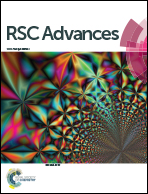Fe3O4 nanopearl decorated carbon nanotubes stemming from carbon onions with self-cleaning and microwave absorption properties†
Abstract
Electromagnetic wave absorbing materials with a microwave absorption capacity over a wide frequency range and a superhydrophobic surface are of great importance for their applications in stealth technology, particularly, in high humidity environments. In this paper, Fe3O4 nanopearl decorated carbon nanotubes stemming from carbons onions (CNOs/CNTs@Fe3O4) have been successfully fabricated using a facile flame strategy, with brass foil as a substrate and catalyst. Fe3O4 nanopearls from the thermal decomposition of iron(III) acetylacetonate were in situ decorated on carbon nanotubes stemming from the ripening of the self-assembly of carbon onion aggregates from the incomplete combustion of ethanol. Notably, this nanocomposite film exhibited a good microwave absorption performance with a wide absorption frequency over a range of 6–18 GHz based on the cooperation of the dielectric loss of the carbon nanotubes and the magnetic loss of the Fe3O4 nanoparticles. Furthermore, the nanocomposite film displays superhydrophobic properties and a low adhesive force that makes it a good candidate for water shedding stealth materials.


 Please wait while we load your content...
Please wait while we load your content...